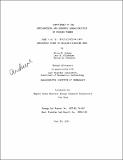| dc.contributor.author | Andeen, Bruce Robert | |
| dc.contributor.author | Glicksman, Leon R. | |
| dc.contributor.author | Rohsenow, Warren Max | |
| dc.date.accessioned | 2005-09-15T14:47:04Z | |
| dc.date.available | 2005-09-15T14:47:04Z | |
| dc.date.issued | 1974 | |
| dc.identifier.other | 01436170 | |
| dc.identifier.uri | http://hdl.handle.net/1721.1/27266 | |
| dc.description | Improvement of the environmental and economic characteristics of cooling towers, pt. 1 | en |
| dc.description.abstract | As fluidized beds can result in an order of magnitude increase in
the heat transfer coefficinet for a surface, they can potentially be
coupled with dry cooling towers for power plant heat rejection. On
such a large scale, economic considerations necessitate the use of an
inexpensive particle and shallow bed depths. Existing heat transfer
mechanism models for fluidized beds are discussed, and a new model
presented. Heat transfer coefficients from a horizontal tube in a
row of dummy tubes to a shallow fluidized bed were experimentally
measured. Coefficients from banks of horizontal tubes are lower than
coefficients from vertical walls primarily because of particle
stagnation on the tube tops and particle recirculation problems.
Experimentally, different tube and distributer geometries were tried
in order to reduce stagnations and enhance particle recirculation.
Experimental data for these different geometries is compared to
exising horizontal tube correlations and the new model. The RMS
deviation of data from the model is less than 17%. The best correlation
was obtained by modifying the Vreedenberg correlation to include a
dependency on the particle fraction of the bed. The RMS deviation of
data from the modified Vreedenberg correlation was 13.8%.
Using both experimental data and the modified Vreedenberg
correlation, economic optimizations were performed to compare fluidized
bed dry cooling towers to a finned tube tower. For a 1000 mw plant,
heat exchanger costs are 13% lower for fluidized beds, but the fluidized
bed is severely penalized by the cost for the power needed to keep the
bed fluidized. The incremental cost of the fluidized bed is 16% higher
than that for a finned surface, but rapidly approaches the finned tube
incremental cost as the particle size and bed depth are reduced. | en |
| dc.description.sponsorship | Empire State Electric Energy Research Corporation, New York | en |
| dc.format.extent | 6227405 bytes | |
| dc.format.mimetype | application/pdf | |
| dc.language.iso | en_US | en |
| dc.publisher | MIT Energy Lab | en |
| dc.relation.ispartofseries | MIT-EL | en |
| dc.relation.ispartofseries | 74-007 | en |
| dc.subject | Cooling towers | en |
| dc.subject | Fluidization | en |
| dc.subject | Heat -- Transmission | en |
| dc.title | Heat rejection from horizontal tubes to shallow fluidized beds | en |
| dc.type | Technical Report | en |
